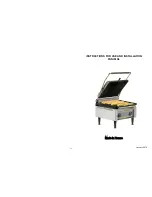
12
Mobile Installation - Portable LP Gas/
Propane
Recommended minimum LPG/propane cylinder capacity for use with
this appliance is 4kg. Maximum LPG/propane cylinder capacity for use
with this appliance is 10kg. In the USA, only a 20lb cylinder may be
used.
Fit the regulator to the LPG/propane cylinder, as shown on the right.
Secure all joints spanner (wrench) tight but do not over-tighten.
For POL cylinders, tighten
anti-clockwise
For Quick Connect
cylinders, tighten clockwise
Before You Begin
Check that the gas type is correct for your type of gas.
You will find the gas type
label on the side of your barbecue. If your barbecue is of the incorrect gas type, or if
you are unsure, consult your dealer before going any further.
This appliance must have a minimum clearance from combustible materials of 450 mm
(18”) on all sides of the barbecue.
Do not install the appliance under or on any combustible surface.
The appliance must be tested for safe and proper operation on completion of
installation.
Keep ventilation openings in the lower cabinet clear and free of any debris.
This barbecue is not approved for use on marine craft.
Fixed Installation - Portable LP Gas/Propane
.
BeefEater LPG/propane barbecues are designed to operate at 2.75Kpa (11”WC). .
Connect the gas supply line to the barbecue inlet located on the right side of the appliance using either hard
plumbing, or a flexible hose connected to a bayonet point, also known as a quick connect fitting. Refer to AS
5601 or your local installation code for pipe sizing details. Secure all joints spanner (wrench) tight but do not
over-tighten.
Test gas pressure by removing the last burner from the left hand side of the barbecue and attaching a hose
and pressure gauge to the end of the gas valve. Turn on 2 burners and check the pressure. Inlet pressure
should be 11.0” WC or 2.75 kPa.
Australia only: For mobile trolley installations that use flexible hosing to connect to natural gas, a chain or
similar restraining device must be fitted to prevent strain on the gas supply line. One end of the chain
should attach to the barbecue; the other end should attach to a fixed structural point close to where the hose
connects to the gas piping. The chain must be at least 30% shorter than the gas supply line. In this way, if
the barbecue is accidentally moved, the chain stops the barbecue from stretching the hose.
Installation
NATURAL
GAS
RE
F
E
R
T
O
L
O
CA
L
GAS AUTHORITY FOR CONFIRMATION OF GAS
TY
P
E
IF
IN
D
O
U
BT
LPG
PROPANE
GAS
RE
F
E
R
T
O
L
O
CA
L
GAS AUTHORITY FOR CONFIRMATION OF GAS
TY
P
EI
F
IN
DO
UB
T
sl4000_0805.indd 12
14/12/2006 10:17:03 AM













































